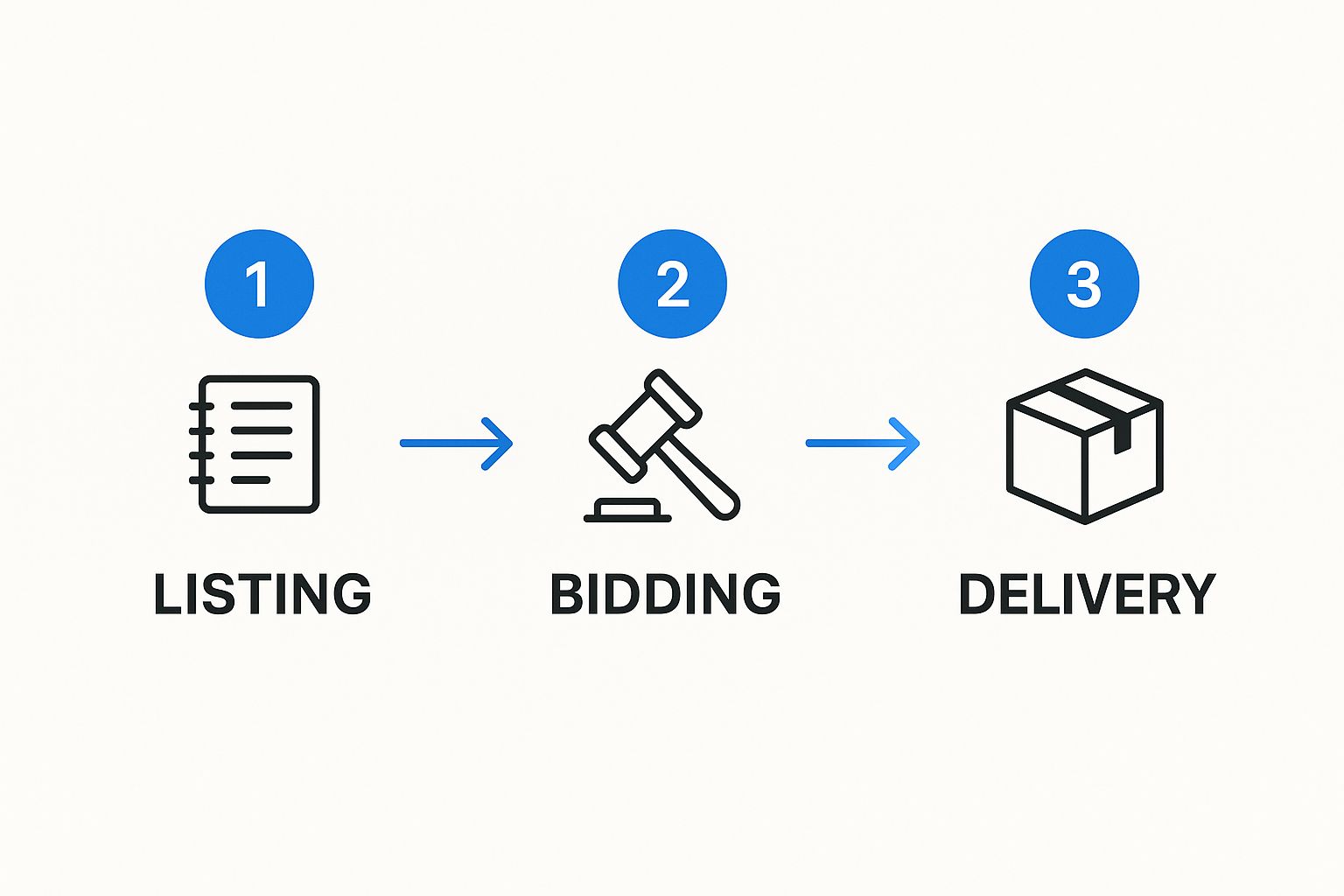Your Guide to Estate Auction Websites

If you've ever spent a weekend driving from one estate sale to another, hoping to find a hidden gem, you already understand the appeal. Now, imagine that entire experience, but without the driving, the crowds, or the geographical limits.
That’s exactly what estate auction websites are. They’ve taken the time-honored tradition of the local estate sale and brought it online, creating a global marketplace you can access right from your laptop.
What Are Estate Auction Websites Anyway?
Think of it as a treasure hunt on a massive scale, available 24/7 from the comfort of your home. These platforms digitize the process of liquidating a home's contents, opening up bidding to anyone, anywhere.

Instead of just competing with other locals on a Saturday morning, you're now part of a much larger community of buyers. This digital shift means a once-local collection of personal property is now visible to enthusiasts and collectors across the country, or even the world.
The Thrill of the Digital Hunt
What really gets people hooked is the incredible variety. One minute you’re looking at a classic mid-century modern armchair, and the next you’re bidding on a box of rare comic books or a set of antique sterling silver. That element of discovery is what makes it so exciting.
These aren't just used goods; they’re often items with a story. You’re not just buying a piece of furniture, you're buying a piece of history that’s ready for its next chapter in a new home. It's this mix of history, potential rarity, and sheer convenience that has caused their popularity to skyrocket.
At their heart, estate auction websites democratize treasure hunting. They remove geographical barriers, allowing a collector in California to acquire a piece from a historic estate in New England with just a few clicks.
Why Are These Sites So Popular?
The explosive growth of these platforms isn't surprising when you look at what they offer. For bidders, it’s a shopping experience that traditional retail or scattered online marketplaces simply can't replicate.
Here’s a breakdown of why so many people are turning to online estate auctions:
- Unmatched Variety: Where else can you find fine art, vintage jewelry, workshop tools, and everyday kitchenware all in one place? The inventory is massive, often full of items no longer in production or made with a quality that’s hard to find today.
- Potential for Great Value: Sure, some rare items can fetch high prices, but many things are won for a fraction of their original cost. The auction format lets demand set the price, which creates real opportunities for bidders who know what they’re looking for.
- The Sustainability Factor: Let’s be honest, buying secondhand is a smart, environmentally-friendly choice. You’re giving well-made objects a new lease on life, which reduces waste and the need for new manufacturing.
Ultimately, these sites provide an engaging and incredibly practical way to furnish a home, grow a collection, or just find that perfect one-of-a-kind piece. They’ve fundamentally changed how we can acquire personal property, blending the classic thrill of an auction with the simplicity of e-commerce.
How Online Estate Auctions Actually Work
Jumping into the world of estate auction websites can feel a little intimidating at first, but the process is surprisingly straightforward. Once an item is earmarked for sale, it follows a simple, three-part journey: listing, bidding, and delivery.
It really is that simple. The whole thing is just a clear, organized flow that gets an item from an estate into the hands of a new owner.

This visual breaks down the entire lifecycle into its core parts, showing that what might sound complex is really just a series of well-defined steps.
The Cataloging and Listing Phase
Before you can even think about placing a bid, every item has to be prepped for its online debut. This first stage is all about presentation, transforming a physical object into a compelling digital listing that grabs attention.
Auction houses or individual sellers will carefully photograph each piece from multiple angles. The goal is to clearly show its condition, highlight interesting details, and point out any flaws or unique features. If you're selling, making product photos look professional is one of the best ways to get top dollar for your items.
After photography comes the description. Each item is cataloged with key details like its dimensions, materials, approximate age, and a condition report. Transparency is everything here—good platforms are always upfront about an item's history and any wear and tear.
Understanding the Bidding Process
This is where the excitement begins. Once an item is listed, the auction goes live for a set amount of time, usually a few days. During this window, registered bidders can place their bids. Let's cover the key terms you'll run into.
- Opening Bid: This is the starting line—the minimum price needed to get the bidding started. It’s often set very low, sometimes just $1, to get people engaged and bidding.
- Proxy Bidding (or Max Bid): Think of this as your secret weapon. Instead of being glued to your screen, you enter the absolute maximum you're willing to pay. The system then automatically bids for you in small increments to keep you in the lead, but only up to your limit. It’s a game-changer.
- Soft Close: To prevent people from swooping in at the very last second (a frustrating practice known as "sniping"), most estate auction websites use a soft close. If a bid comes in during the final few minutes, the clock extends a bit longer. This gives everyone a fair shot to respond, just like the "going once, going twice" call at a live auction.
The real magic of online auctions is how technology creates a fair and dynamic marketplace. Features like proxy bidding and soft closes ensure that the final price reflects true market demand, not just who has the fastest internet connection.
After the Hammer Falls What Next
You won! Now what? The auction might be over, but there are a few final steps to get your new find from their house to yours. The price you see when the auction ends isn't quite the final number; there are a couple of extra costs to be aware of.
The most common addition is the Buyer's Premium. This is a percentage of your winning bid (typically 15-25%) that goes to the auction house for running the sale. This fee is always clearly stated in the auction's terms, so there are no surprises. You’ll also have to pay any applicable sales tax, which depends on your location.
Once you’ve paid the invoice, it’s time to arrange for pickup or delivery.
- Local Pickup: If the auction is close by, you can usually schedule a time to go pick up your items yourself. This is a great way to save a bundle on shipping.
- Shipping: For items that are farther away, the auction company will either handle the shipping themselves or give you a list of trusted third-party shippers. These pros specialize in everything from delicate antiques to bulky furniture.
Getting a handle on these mechanics is the key to bidding with confidence. For a deeper dive, you can check out our full guide on how estate auctions online work from start to finish. Once you know these steps, you’ll be ready to navigate any auction like a pro.
Choosing the Right Auction Platform for You
Not all estate auction websites are created equal. Just like you wouldn't shop at a dimly lit, disorganized store, you shouldn't place bids on a platform that feels untrustworthy or is a pain to use.
Honestly, picking the right website is the single most important step you'll take. It's what ensures a safe, fair, and ultimately successful bidding experience.

Think of the next few points as your personal checklist for vetting these sites. Whether you're a casual browser hunting for unique home decor or a serious collector on the trail of a specific antique, knowing what to look for will give you the confidence to bid.
Core Features of a High-Quality Platform
A great auction website makes finding and evaluating items simple and totally transparent. The whole experience should feel smooth, intuitive, and designed to give you all the information you need right up front. If a site is clunky or seems to be hiding important details, consider that a major red flag.
Here are the non-negotiables every trustworthy platform should have:
- Intuitive Search and Filtering: You need to be able to easily search for items and filter the results by category, location, auction closing time, or price. A powerful search function saves you tons of time and helps you zero in on what you're looking for.
- High-Resolution Photography: Clear, detailed photos are your eyes on the ground. The best sites provide multiple high-quality images from every angle, including close-ups of signatures, maker's marks, and any signs of wear or damage.
- Detailed and Honest Condition Reports: A comprehensive written description is just as vital as the photos. This report should spell out an item's dimensions, materials, and history, and most importantly, be upfront about its condition—scratches, chips, repairs, and all.
These core features build the foundation of trust between you and the auction house. Without them, you're pretty much bidding blind.
Evaluating Trust and Transparency
Beyond the basic user experience, the integrity of an auction platform is everything. You need to know your bids are secure, the fees are clear, and help is available if something goes wrong. This is where you separate the premier estate auction websites from the risky amateur operations.
A huge factor here is the fee structure. Every auction house charges a Buyer's Premium, but reputable platforms display this percentage prominently on every single listing. You should never have to dig through pages of legal jargon to find out how much extra you'll be paying. The same goes for shipping policies and cost estimates.
"A transparent platform operates on a simple principle: an informed bidder is a confident bidder. Hiding fees or obscuring an item's condition only erodes trust and creates a bad experience for everyone."
A platform's reputation also speaks volumes. Look for a long history of successful sales and check for customer reviews on independent sites. See what other users are saying about winning bids, customer service, and whether the item descriptions were accurate.
Finally, give their customer support a test run. Before you even place a bid, try sending a question about an item. A responsive, helpful, and professional support team is a fantastic sign of a well-run organization that actually values its customers. It's the same kind of due diligence you'd do when selecting the best online auction software to run your own sales. A little bit of homework now will pay off big time, ensuring your auction experience is a great one.
Feature Comparison Across Estate Auction Website Types
To help you narrow down your search, it’s useful to understand the different types of platforms out there. From massive national sites to small, specialized sellers, each offers a different experience.
| Feature | National Platforms (e.g., Everything But The House) | Regional Auction Houses (Online Portals) | Niche Specialty Sites (e.g., Fine Art) |
|---|---|---|---|
| Item Variety | Extremely broad; furniture, jewelry, collectibles, cars, and more. | Wide, but often reflects the local region's style and history. | Highly focused on one category, like vintage posters or rare books. |
| Geographic Reach | Nationwide, with shipping and pickup options in many major cities. | Focused on a specific state or metropolitan area; often local pickup only. | International, catering to a global community of collectors. |
| Typical Buyer's Premium | Usually between 15% and 25%. | Can be lower, often in the 10% to 20% range. | Often higher, potentially 20% to 30% or more for premier items. |
| Level of Curation | Varies; some items are professionally vetted, others are sold as-is. | Generally good curation by local experts familiar with the items. | Expert-level curation and authentication is the primary value. |
| Best For | General bargain hunting and finding a wide variety of common household goods. | Finding unique, local treasures and supporting regional businesses. | Serious collectors seeking authenticated, high-value, specific items. |
Choosing the right type of platform depends entirely on your goals. Are you looking to furnish an apartment on a budget, or are you hunting for a museum-quality piece? Answering that question will point you in the right direction.
Why Bidders Are Flocking to Online Auctions
The move to online auctions isn't just a minor tweak—it's a complete shift in how we buy and sell from estates. For buyers on the hunt for unique finds and sellers needing to liquidate assets, these digital platforms have blown the doors wide open to a world of new opportunities.

This explosion in popularity boils down to a pretty simple formula: wider access, better value, and convenience that’s second to none. It’s a modern marketplace that honors the history of the items it sells while fully embracing today’s technology.
Advantages for the Savvy Buyer
If you love the thrill of the hunt, estate auction websites are a total game-changer. The perks go way beyond just being able to bid from your couch.
The biggest win is the incredible access you get to a nationwide—and sometimes global—inventory. You’re no longer limited to the few estate sales happening in your zip code. Now, you can bid on a rare piece of art from a collection three states away just as easily as you can on vintage furniture from across town.
This massive pool of items also means you can find some incredible deals. Sure, the rarest items will always draw a crowd, but the sheer volume means countless unique, high-quality goods can be won for very competitive prices. It's a true market where demand, not a price tag, sets the final value.
The core appeal for bidders is the democratization of discovery. An online platform removes geographical friction, allowing a unique item to find its perfect new owner, regardless of where they live.
And you just can't overstate the convenience. You can browse, do your homework, and place bids anytime, day or night, from your phone or laptop. That kind of flexibility fits into real life in a way a traditional, in-person auction just can’t.
Benefits for the Modern Seller
Sellers are also seeing huge rewards from this digital model. The most obvious benefit is getting your items in front of a much, much larger audience. Instead of a few dozen local folks showing up, your listings are seen by thousands of interested bidders, which naturally helps drive final sale prices higher.
On top of that, the efficiency of an online sale is a massive draw. A professional auction company takes care of all the heavy lifting for you:
- Cataloging and Photography: Every single item is professionally documented and photographed to spark maximum interest.
- Marketing and Promotion: The sale gets advertised to a targeted list of buyers who are already looking for the kinds of things you’re selling.
- Payment and Logistics: They handle all the secure payment processing and coordinate pickup or shipping, so you don’t have to.
This streamlined process not only gets you a better financial return but also massively cuts down on the stress and hard work of liquidating an estate.
A Sustainable and Growing Marketplace
Beyond the practical perks, there's a powerful cultural shift pushing online auctions forward. More and more people are focused on sustainability, choosing to buy quality, pre-owned goods instead of brand-new ones. This eco-conscious mindset makes estate auctions an attractive—and responsible—way to shop.
The property auction market is feeling the same momentum, with technology and new buyer habits leading the charge. The move to online property auctions is only going to grow, as it gives buyers the freedom to bid from anywhere and gives sellers access to a far wider pool of bidders. This shift is creating a more efficient and accessible market, breaking down old geographical barriers. You can explore more on upcoming property auction market trends to see just how this digital evolution is reshaping the entire industry.
The Big Picture: What's Driving the Online Auction Boom?
To really get why estate auction websites work so well, you have to look at the bigger picture. These aren't just little websites selling knick-knacks; they're part of a massive global shift in how we buy and sell things, all powered by technology.
Think of it like this: decades ago, selling estate items meant relying on local antique shops or a handful of collectors in your town. It was like a farmer's market—your reach was limited to whoever was physically nearby. Today, technology has completely torn down those walls. A collector in Tokyo can now bid on a piece from a quiet estate in Ohio just as easily as if they were standing in the living room.
The Forces Behind the Growth
A few powerful trends are fueling the explosive growth of this market. For one, there's a huge cultural shift toward sustainability. People are actively choosing pre-owned items with a story and a history over generic, mass-produced goods. This isn't just a fad; it's a real economic force.
On top of that, we've all gotten used to the convenience of e-commerce. We expect buying and selling to be easy, transparent, and secure, whether we're buying a new toaster or a vintage armchair. The best auction platforms deliver exactly that. When you combine these trends, you get a strong, legitimate, and rapidly growing market. Making sense of it all often means applying smart data-driven marketing approaches to connect the right items with the right buyers.
The online auction world isn't just about selling old things. It's a dynamic ecosystem fueled by a desire for sustainability, a search for unique stories, and the powerful reach of modern e-commerce.
This chart from Dataintelo really tells the story of the market's incredible growth.
You can see the clear upward trend, proving this is a fundamental change in how we do business, not just a passing phase.
A Market of Incredible Scale and Opportunity
The numbers here are staggering. The global online auction market was valued at around USD 5.25 billion in 2023. That’s already huge, but it's projected to more than double, hitting USD 11.3 billion by 2032. That kind of growth shows just how much momentum is behind this shift. You can dig deeper into the global online auction market at dataintelo.com for more details.
North America, in particular, has become a major hub for online auctions, and it’s easy to see why:
- Rock-Solid E-commerce: We have the reliable payment systems and shipping logistics needed to make it all work smoothly.
- Widespread Internet Access: Nearly everyone is online and comfortable making significant purchases through their phone or computer.
- A Culture of Collecting: There’s a deep-rooted appreciation for vintage and antique goods, which means there’s always a ready market of eager buyers.
This entire system—from listing an item to processing the final payment—is built on trust and technology. Getting a handle on the financial details, like knowing what are transaction fees and how they factor in, is crucial for both buyers and sellers. It’s this combination of factors that makes the modern-day global treasure hunt possible.
The Future of Finding and Selling Treasures
We’ve covered a lot of ground, from what estate auction websites are to how you can pick the right one for your needs. It’s pretty clear these platforms aren’t just a passing trend—they're fundamentally changing how we find, buy, and sell items with a story.
Think of them less like websites and more like global treasure chests that are constantly being refilled. They connect unique objects with new owners who will cherish them, completely erasing the old limits of geography. The thrill of the hunt, which used to be a local affair, is now available to anyone, anytime, right from their phone.
A Market That's Just Getting Started
And this isn't just a niche hobby; it's a massive industry with some serious momentum behind it. The global auction house market is on track for some major expansion.
By 2025, it’s expected to be a $50 billion market. From there, it’s forecasted to grow at a compound annual growth rate of 7% and hit roughly $85 billion by 2033. A huge part of that growth comes directly from the accessibility and reach of online platforms. If you want to dig deeper, you can explore more about these market projections and see where the industry is headed.
The rise of online auctions is the perfect storm of smart technology meeting a timeless human desire for discovery. It’s sustainable, it's exciting, and it’s a better way to buy and sell.
Whether you're furnishing a home with one-of-a-kind pieces, building out a special collection, or just love the excitement of placing a bid, there’s never been a better time to jump in. The world of online estate auctions is huge, welcoming, and full of incredible things just waiting to be found.
So go ahead and explore with confidence. Enjoy the thrill of your next great discovery.
Frequently Asked Questions
Jumping into the world of estate auction websites for the first time? You probably have a few questions. Getting straight answers is the key to bidding with confidence and actually enjoying the thrill of the hunt. Here are the things most new bidders want to know.
How Can I Be Sure an Item Is Authentic?
This is a big one, especially when you’re looking at high-value pieces like fine art, signed collectibles, or antique jewelry. Reputable platforms know that trust is everything, and they take authentication very seriously.
The best estate auction websites have specialists on staff or work with outside experts to verify items before they ever go live. When you’re browsing, look for specific details in the description that back up an item’s story:
- Provenance: This is just a fancy word for the item's documented history of ownership.
- Certificates of Authenticity (COA): Official paperwork that guarantees an item is the real deal.
- Expert Appraisals: Reports from qualified pros confirming what an item is and what it’s worth.
- Maker's Marks or Signatures: Clear photos of hallmarks on silver, an artist's signature, or designer labels on furniture.
If a listing is vague and lacks these details, it’s a red flag. Your safest bet is always to stick with well-established auction sites that have a long history of expert curation. And before you even think about bidding, read the platform’s return policies and authenticity guarantees.
What Hidden Costs Should I Expect?
The number you see on your winning bid is rarely the final price you’ll pay. It’s critical to understand the extra costs before you get caught up in the excitement so you can budget accurately and avoid any nasty surprises.
The two most common additions are the Buyer's Premium and shipping. The Buyer's Premium is a percentage of the winning bid that goes to the auction house for their services—think of it as their commission for finding, cataloging, and managing the sale. This fee usually falls somewhere between 15% and 25% and is always spelled out in the auction’s terms.
Shipping is the other big variable. A small book might be cheap to mail, but a fragile antique mirror or a heavy piece of furniture can be expensive to pack and transport safely. Always use the site’s shipping estimator or contact the auction house for a quote before you bid. That way, you’ll know your true all-in cost. And don't forget, sales tax will be added based on where the item is being delivered.
How Do I Avoid Being Outbid at the Last Second?
It’s incredibly frustrating. You watch an item for days, only to lose it in the final seconds to a last-minute bidder. This practice, known as "sniping," is a common headache, but good platforms have smart features to make the whole process fairer.
The best defense is a soft close. If someone places a bid in the final moments, this feature automatically extends the auction clock by a few minutes. It works just like a live auctioneer saying "going once, going twice," giving everyone a fair chance to respond instead of rewarding the person with the fastest internet connection.
The smartest thing you can do is use the 'proxy bid' feature. You decide the absolute maximum you're willing to pay and enter it upfront. The system will then automatically bid for you in small increments to keep you in the lead, but only up to your limit.
This automated bidding is your secret weapon. It keeps you competitive without you having to be glued to the screen and ensures you don't lose by a tiny margin just because someone else clicked a second faster.
Can I See an Item in Person Before Bidding?
Whether you can get your hands on an item before you bid really depends on the auctioneer. Many traditional auction houses that also run online sales will host in-person preview days. These are great opportunities to examine items up close, check their condition, and talk directly with the staff.
For most purely online estate auction websites, however, physical previews just aren't possible. In these cases, you have to become a detective and rely entirely on the online listing. This means you need to meticulously review every single photo, zoom in on the details, and read the condition report from top to bottom. If you still have questions, don’t hesitate to contact customer support and ask for more information or extra pictures. A trustworthy seller will be happy to provide whatever you need to feel confident in your bid.